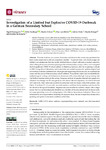2022-01-04Zeitschriftenartikel
Investigation of a Limited but Explosive COVID-19 Outbreak in a German Secondary School
Baumgarte, Sigrid
Hartkopf, Felix
Hölzer, Martin
von Kleist, Max
Neitz, Sabine
Kriegel, Martin
Bollongino, Kirsten
The role of schools as a source of infection and driver in the coronavirus-pandemic has been controversial and is still not completely clarified. To prevent harm and disadvantages for children and adolescents, but also adults, detailed data on school outbreaks is needed, especially when talking about open schools employing evidence-based safety concepts. Here, we investigated the first significant COVID-19 school outbreak in Hamburg, Germany, after the re-opening of schools in 2020. Using clinical, laboratory, and contact data and spatial measures for epidemiological and environmental studies combined with whole-genome sequencing (WGS) analysis, we examined the causes and the course of the secondary school outbreak. The potential index case was identified by epidemiological tracking and the lessons in classrooms with presumably high virus spreading rates and further infection chains in the setting. Sequence analysis of samples detected one sample of a different virus lineage and 25 virus genomes with almost identical sequences, of which 21 showed 100% similarity. Most infections occurred in connection with two lesson units of the primary case. Likely, 31 students (12–14 years old), two staff members, and three family members were infected in the school or the typical household. Sequence analysis revealed an outbreak cluster with a single source that was epidemiologically identified as a member of the educational staff. In lesson units, two superspreading events of varying degrees with airborne transmission took place. These were influenced by several parameters including the exposure times, the use of respiratory masks while speaking and spatial or structural conditions at that time.
Dateien zu dieser Publikation

